The ocean has always inspired the imagination, creating ideas of the great unknown, the power of nature, and the possibilities for exploration and domination. Nautical themes in oil paintings may commemorate naval battles, embellish metaphorical ideas, form the backdrop to grand mythological scenes, or simply capture the beauty of a seascape. With so many possibilities for this artistically engaging setting, nautical paintings are often found in auction houses and galleries around the world.
These popular scenes adorn the walls of many homes, and when damaged find their way to our team at Fine Art Restoration Company. The dazzling and often dynamic shades used to bring the ocean to life are vital to the composition, so when these areas become discoloured due to yellowing varnish or mould growth there is a devastating loss to the overall impact. Furthermore, tears to the canvas may require an experienced conservator, as smooth ocean surfaces and gradients in sunset skies need a high level of skill to colour-match missing areas for a seamless result.
 Above: a nautical oil painting at the beginning of a restoration process, during a varnish removal in our studio
Above: a nautical oil painting at the beginning of a restoration process, during a varnish removal in our studio
Our team have expertly restored many marine paintings, from renaissance and baroque artwork through to Victorian romanticism and contemporary pieces, making them well versed in this subject. In this article we will explore the themes and history of nautical paintings, as well as the restoration treatments they may typically require.
Exploring nautical paintings
The ocean has been a predominant theme in western art since ancient civilisation, this is especially due to the sea faring nations of classical antiquity such as the Greeks. The Aegean and Mediterranean seas were central to the trade and imagination of these cultures, bringing about numerous myths and legends which would be incorporated into epic poetry and art. The most famous of these include Homer’s Odyssey, the tale of Odysseus and his crew on a turbulent voyage home facing the wrath of gods and monsters. The Odyssey is a defining cultural artefact which has inspired stories and artwork throughout history, like many classical works it may often be referenced in paintings as a central scene or as an extra layer of allegory.
 Above: a scene depicting Odysseus and his crew escaping Polyphemus the cyclops by Arnold Böcklin, 1896
Above: a scene depicting Odysseus and his crew escaping Polyphemus the cyclops by Arnold Böcklin, 1896
From the 15th century, the Netherlands became a dominant seafaring nation and this is shown in the predominance of marine art from this period and beyond. From the 17th century, over 70% of the world’s trade passed through the ports of Amsterdam. Traditional Dutch art includes many depictions of everyday life in marine trade, as well as naval war scenes and drama at sea. This may have been compelled by the Dutch style of looking down from a high point in a landscape, allowing for a large body of water to be viewed with panoramic scope. Some of these seascapes also became subtle reflections of biblical or classical stories.
 Above: ‘Landscape with the Fall of Icarus’ by Pieter Bruegel, 16th century (you can see Icarus in the water bottom right)
Above: ‘Landscape with the Fall of Icarus’ by Pieter Bruegel, 16th century (you can see Icarus in the water bottom right)
A famous example is Pieter Bruegel the Elder’s Landscape with the Fall of Icarus, which upon first glance appears as a simple port scene, before you notice the legs protruding from the water surrounded with feathers from his diminished wings. This combines the marine tradition with the high artform of ‘history painting’, elevating the genre through the use of academic creativity. The naval war scenes, however, were much more straightforward in being commemorative of the nation’s power and dominance over territories or the sea itself. These naval depictions became popular throughout Europe as a way of recording a victory with dramatic effect.
 Above: a detail from ‘Shipwreck in Stormy Seas’ by Claude-Joseph Vernet, 1773
Above: a detail from ‘Shipwreck in Stormy Seas’ by Claude-Joseph Vernet, 1773
Depictions of the ocean often offer a personification of the body of water, whether this is a glimpse into the perilous wrath of the waves or the tranquil calm. The mood of the ocean often enhances a composition, bringing an ambience which either compels the central theme or hints towards past or future changes to the scene, for instance the calm before a storm.
 Above: a detail from ‘Watson and the Shark’ by John Singleton Copley, 1778
Above: a detail from ‘Watson and the Shark’ by John Singleton Copley, 1778
As exploration of the Americas continued throughout the 17th and 18th centuries, artwork reflected on the perils of the ocean, often based on true accounts of shipwrecks and unidentified new creatures which dwelled in unexplored waters. As the printing press developed in the enlightenment period of the 18th century, dramatic stories of the sea and the exotic features of the ‘new world’ were often recounted in pamphlets. Artists who were looking for an intriguing and commercial subject often turned to these tales, in hopes that engravings of their artwork could be widely sold. Sometimes the subjects of the tale would commission the painting themselves, as was the case with John Singleton Copley’s Watson and the Shark, which was commissioned by Mr. Watson to dramatically recount the time his leg was taken during a shark attack in Havana. The painting exaggerates the ferocity and size of the shark, an animal which the artist would have never seen in person, and is reflective of classical tales of ocean dwelling monsters.
 Above: a detail from ‘The Ninth Wave’ by Ivan Aivazovsky, 1850
Above: a detail from ‘The Ninth Wave’ by Ivan Aivazovsky, 1850
The mainstream shift of art in the Romantic period produced many seascapes as purely decorative and tranquil pieces, experimenting with colours and with some later artworks heading towards abstractism. The gradient palette of Ivan Aivazovsky’s ‘Ninth Wave’ is typical of this period, an attractive scene which still holds onto the melodrama of a shipwreck. As well as this, the painting subtly hints towards a biblical theme with the masts in the shape of the cross, possibly offering an idea of Christ as a savior or path to redemption.
 Above: a detail from ‘Whalers’ by Joseph Mallord William Turner, 1845
Above: a detail from ‘Whalers’ by Joseph Mallord William Turner, 1845
The most famous marine artist of the 19th century is J. M. W. Turner, whose work took into account all of the themes of the past when producing ocean scenes, including both industrial and classical ideas. In an early painting from 1796 entitled ‘Fisherman At Sea’ it was reflected that Turner had produced “a summary of all that had been said about the sea by the artists of the 18th century”.
Must-see nautical paintings
- Fishing for Souls (1614) by Adriaen van de Venne
- Ships in Distress (1690) by Ludolf Bakhuizen
- Watson and the Shark (1778) by John Singleton Copley
- The Raft of the Medusa (1818) by Théodore Géricault
- The Stages of Life (1835) by Caspar David Friedrich
- The Fighting Temeraire (1838) by J. M. W. Turner
- The Ninth Wave (1850) by Ivan Aivazovsky
- Impression, Sunrise (1872) by Claude Monet
- Breezing Up (1873) by Winslow Homer
Restoring nautical paintings
The vivid and often dramatic nature of a seascape benefits from the bright, original tones of the composition. When this is hidden behind decades of debris, contamination and perishing varnish, the piece may lose much of it’s impact and value. The most common restoration treatment for a marine painting is a varnish removal, which our conservators complete over several hours (depending on the size of the artwork) with a tailored solvent and small cotton swab, which is continuously swapped out for a new one, so as not to move any particles of dirt. Following a varnish removal, the white seafoam and ship sails often have a noticeable unveiling, as they are no longer hidden beneath a layer of discolouration. The blues of the ocean and graduated colours of a horizon sky will stand out as they did when the painting was first completed. This is then protected with a new conservation-grade varnish, which filters UV rays and has a non-yellowing quality.
 Above: a nicotine stained ocean view before and after a varnish removal and surface clean by our conservators
Above: a nicotine stained ocean view before and after a varnish removal and surface clean by our conservators
Warping and distortion
In 2020, our team worked on a 19th century port scene of a family in a rowing boat. The piece was by Frederick Bridgman (1847-1928), an prolific American artist who specialised in Orientalist themes before spending time in Paris, this painting is from his French Period but captures some of the same themes from his prior work. In this artwork it is notably the tranquil boat ride which also features in his scenes from Egypt and Istanbul. By 1890 Bridgman had over 400 paintings on display in New York’s 5th Avenue gallery, due to the popularity of his paintings and the commercial frequency at which they were produced. The unique elements of his composition in our studio included bright and clear water, in which you could enjoy the details of the sea floor, as well as the perceived movement of the boat as it is rowed.
 Above: the painting warped in the frame after falling from height (right) and the painting following restoration by our team (left)
Above: the painting warped in the frame after falling from height (right) and the painting following restoration by our team (left)
This oil painting had fallen from height due to insufficient installation. The canvas became distorted, with areas of dents and warping. Our conservator began with a varnish removal, which enhanced the colours further. The piece was then removed from the stretcher bars and given a careful weight treatment to correct the distortion.
Retouching missing paint
Another artwork which our team worked upon from this romantic 19th century period featured a large pastel toned sunset, which had a gradient of pale blue, light yellow, with hints of pinks and purples. The specific blend of these colours made the piece a challenging one to perfectly match, as our conservator had to retouch an area with missing paint. This area had been caused by silver polish accidentally adhering to the surface. This is alarming as the chemicals in the polish could be extremely harmful to the historic painting. Our conservators carefully removed any contamination, and where the painting was disturbed they sympathetically reapplied pigments to give a smooth and even finish, expertly colour-matching with artistic skill to both stabilise the area and reduce visual disturbances.
 Above: the sunset boat scene before restoration with disturbances caused by accidental damage in the upper left corner
Above: the sunset boat scene before restoration with disturbances caused by accidental damage in the upper left corner
Contamination
The majority of large naval battle scenes, dramatic seascapes and technical painting of ships require gentle and tailored cleaning to remove a build up of dirt and contaminants, which have gathered over the course of its life. This debris can sometimes contain toxic particles from soot and nicotine smoke, especially as these artworks come from areas where open fireplaces and indoor smoking were common. Over time these toxins can degrade the varnish layer and the paint, leading to weakness and loss. The varnish itself may also be causing discolouration, as historic varnishes can darken due to organic decay, leaving the paint layer without sufficient protection. But most obviously, they visually disturb the artwork and take away its impact continuously as decades pass by.
 Above: before and after a discoloured varnish removal by our conservators on a George Morland nautical scene of smugglers in a cove
Above: before and after a discoloured varnish removal by our conservators on a George Morland nautical scene of smugglers in a cove
A painting which has muted tones or a light veil may be affected by mould growth or blanching from moisture damage. This also requires a varnish removal to clear away any active spores (preventing them from returning) and moisture which may cause deterioration to the paint layer.
No matter how thick the varnish, debris, or mould on a painting is, our professional conservators can find the correct solution to clear this away and revive the artwork. In most cases this will be a specific solvent mixture, but in cases of very thick contaminants they may use specialist gels. The result will reveal the original colours and remove any dangers which lurked on the surface. In some cases it may also reveal hidden areas. A new synthetic varnish will be used, replacing the historic layer with a variety which offers greater protection from the environment.
 Above: a painting with British ships with a thick layer of smoke and soot damage, part way through removal of contamination by our team
Above: a painting with British ships with a thick layer of smoke and soot damage, part way through removal of contamination by our team
Nautical artists to look out for…
- Charles Brooking (1723-1759)
- Joseph Ridgard Bagshawe (1870-1909)
- Phillipe Loutherbourg (1740-1812)
- Montague Dawson (1895-1973)
- George Balmer (1805-1846)
- Thomas Somerscales (1842-1927)
- Thomas Dutton (1819-1891)
- William Hodges (1744-1797)
- Thomas Buttersworth (1817-1894)
- J. M. W. Turner (1775-1851)
- Simon de Vlieger (1601-1653)
- Stanhope Forbes (1857-1947)
- Nicholas Pocock (1740-1821)
- Richard Eurich (1903-1992)
- Van de Velde the Younger (1633-1707)
- Charles Pears (1873-1958)
- Jan van de Cappelle (1626-1679)
Contact our team for further information
If you have a nautical artwork which you have concerns about, please do not hesitate to reach out to our team who will be happy to help.
You can email [email protected] or call 0207 112 7576.

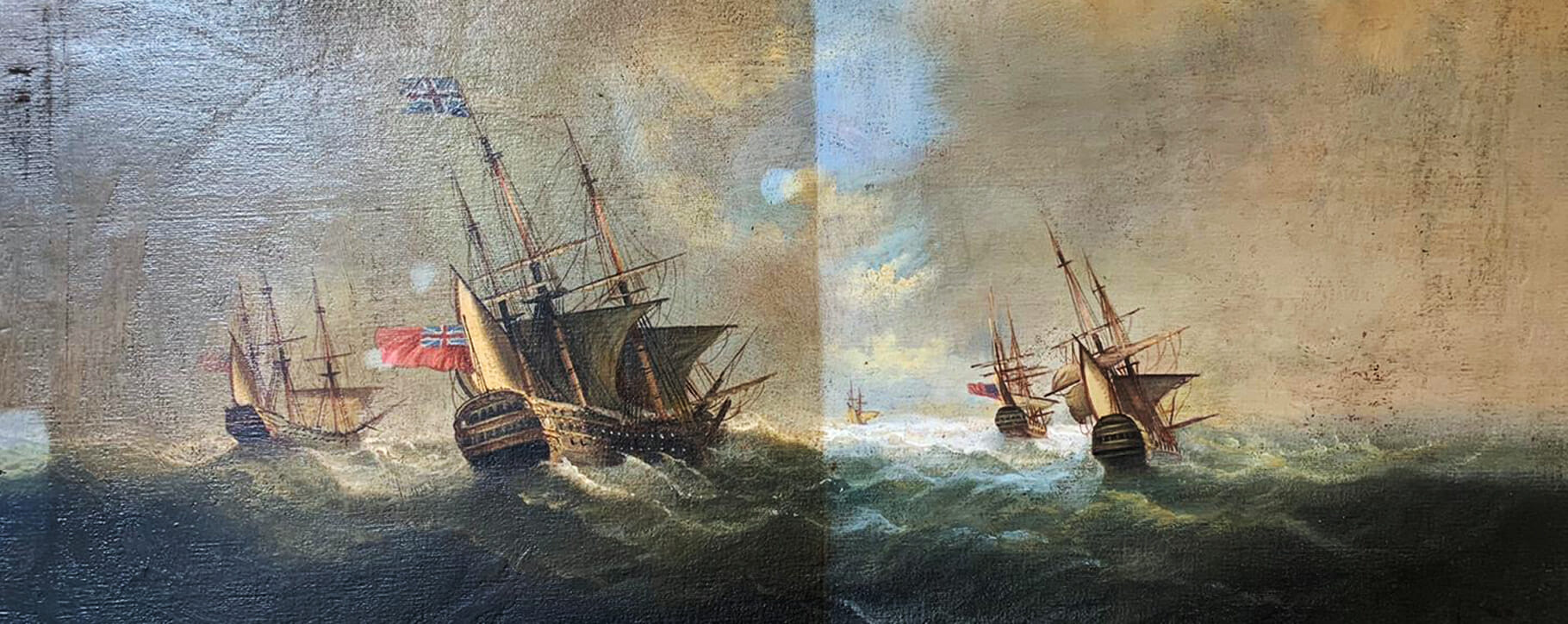 Above: a nautical oil painting at the beginning of a restoration process, during a varnish removal in our studio
Above: a nautical oil painting at the beginning of a restoration process, during a varnish removal in our studio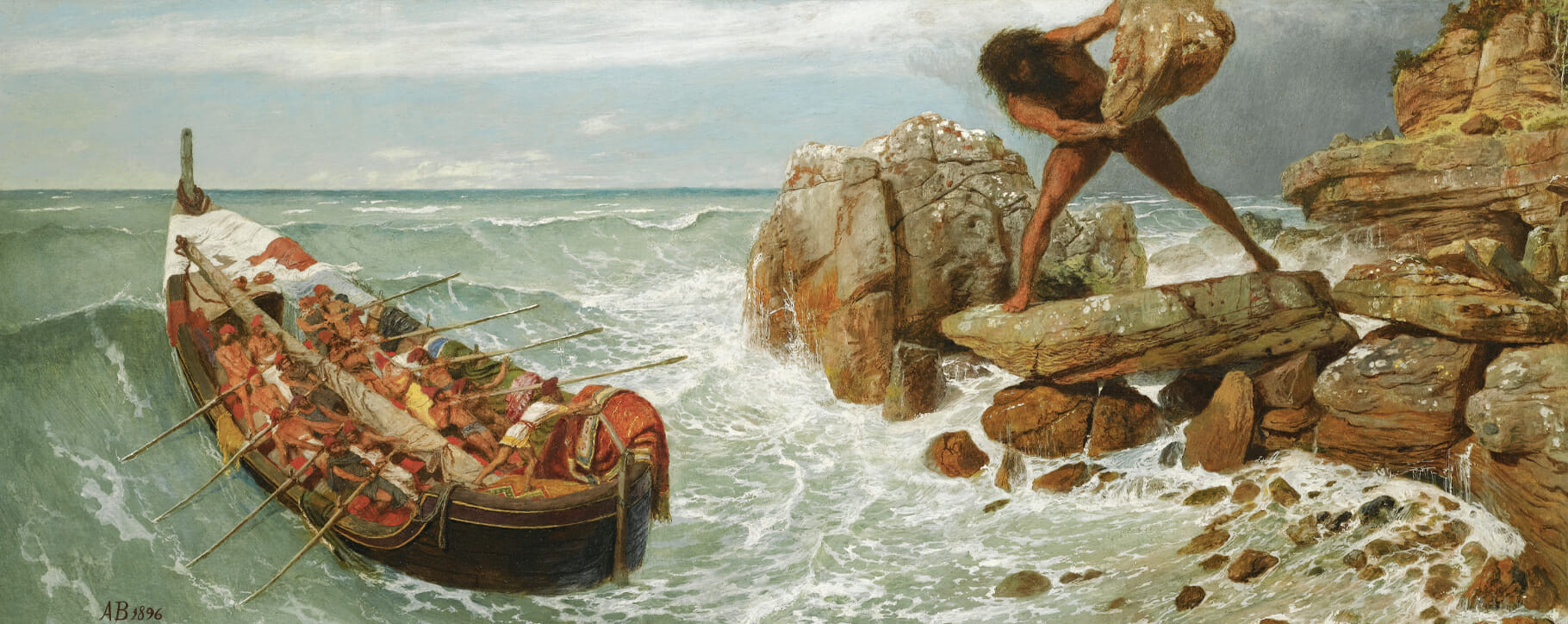 Above: a scene depicting Odysseus and his crew escaping Polyphemus the cyclops by Arnold Böcklin, 1896
Above: a scene depicting Odysseus and his crew escaping Polyphemus the cyclops by Arnold Böcklin, 1896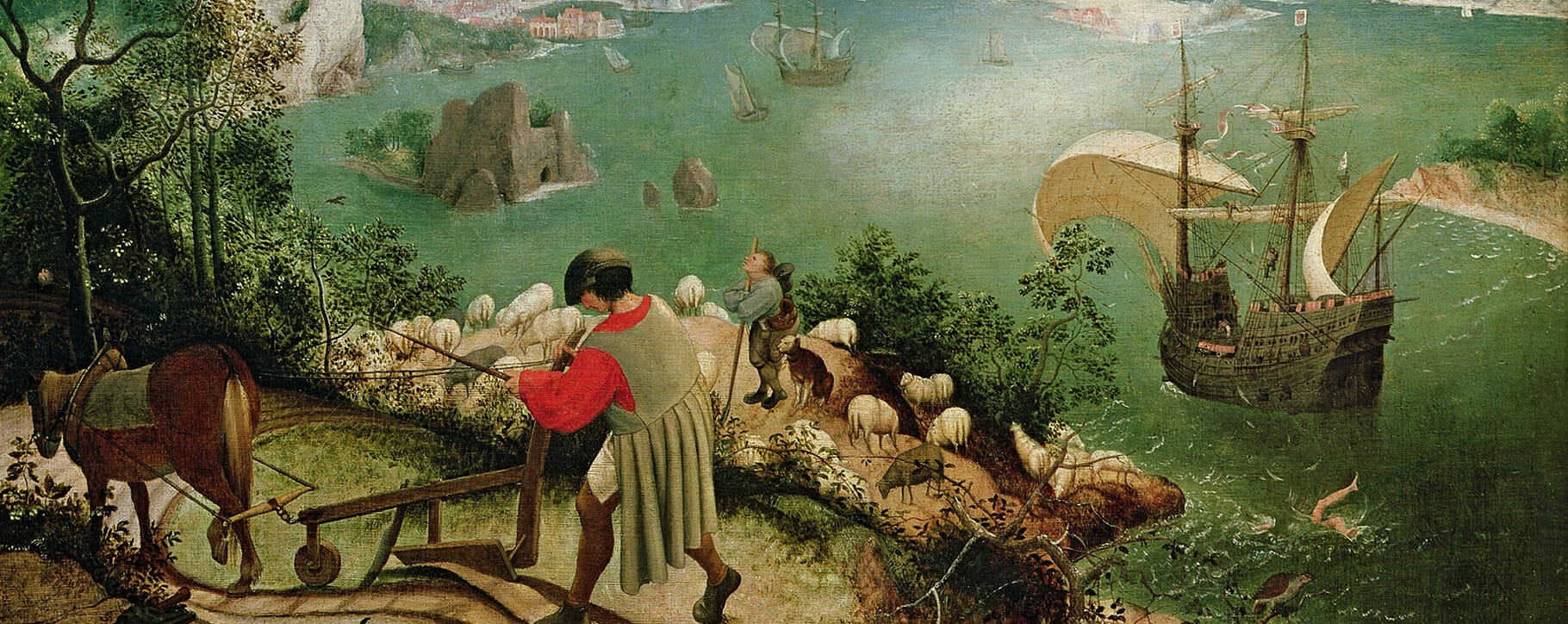 Above: ‘Landscape with the Fall of Icarus’ by Pieter Bruegel, 16th century (you can see Icarus in the water bottom right)
Above: ‘Landscape with the Fall of Icarus’ by Pieter Bruegel, 16th century (you can see Icarus in the water bottom right) Above: a detail from ‘Shipwreck in Stormy Seas’ by Claude-Joseph Vernet, 1773
Above: a detail from ‘Shipwreck in Stormy Seas’ by Claude-Joseph Vernet, 1773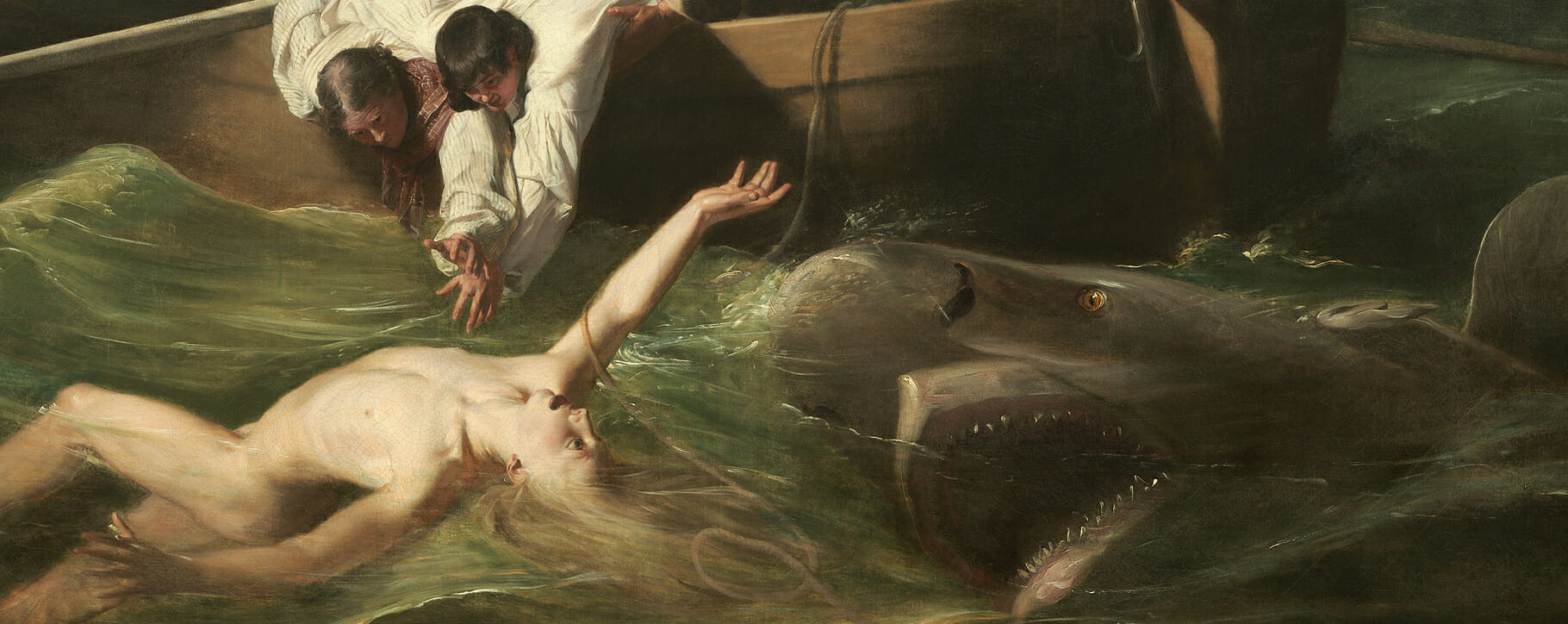 Above: a detail from ‘Watson and the Shark’ by John Singleton Copley, 1778
Above: a detail from ‘Watson and the Shark’ by John Singleton Copley, 1778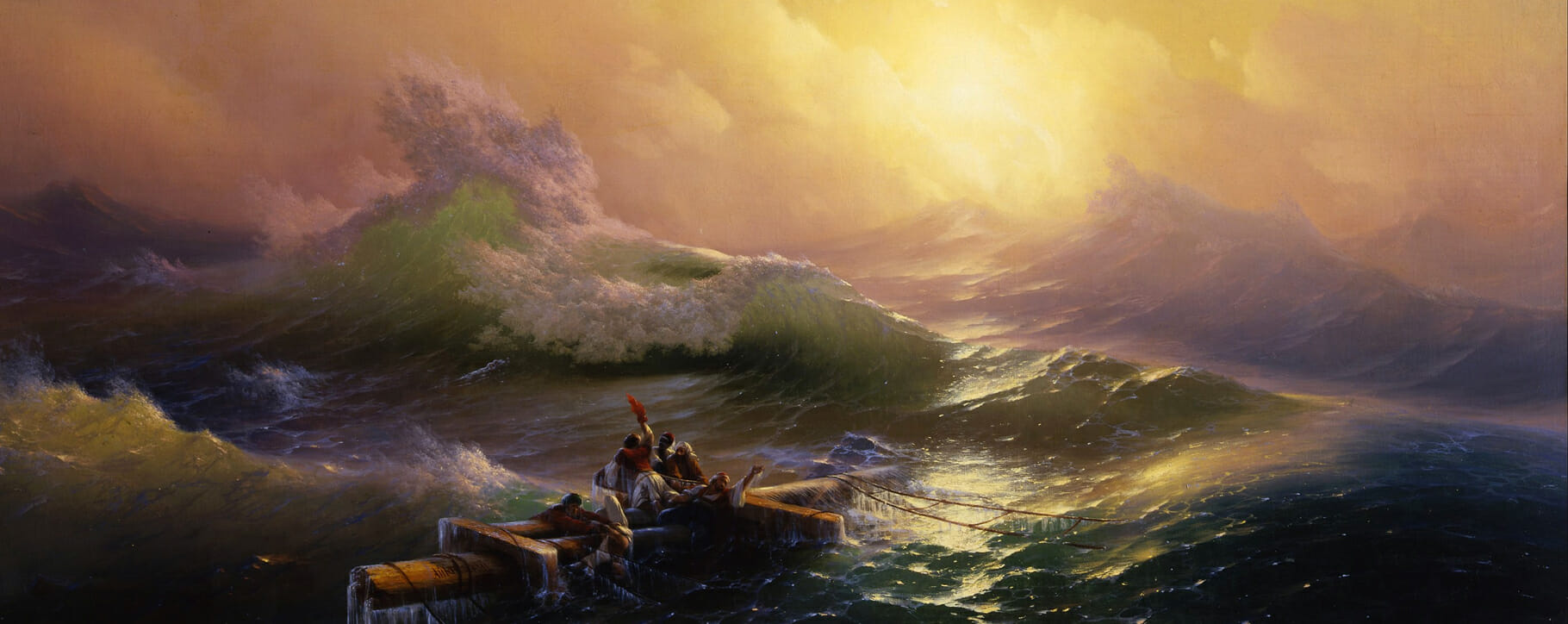 Above: a detail from ‘The Ninth Wave’ by Ivan Aivazovsky, 1850
Above: a detail from ‘The Ninth Wave’ by Ivan Aivazovsky, 1850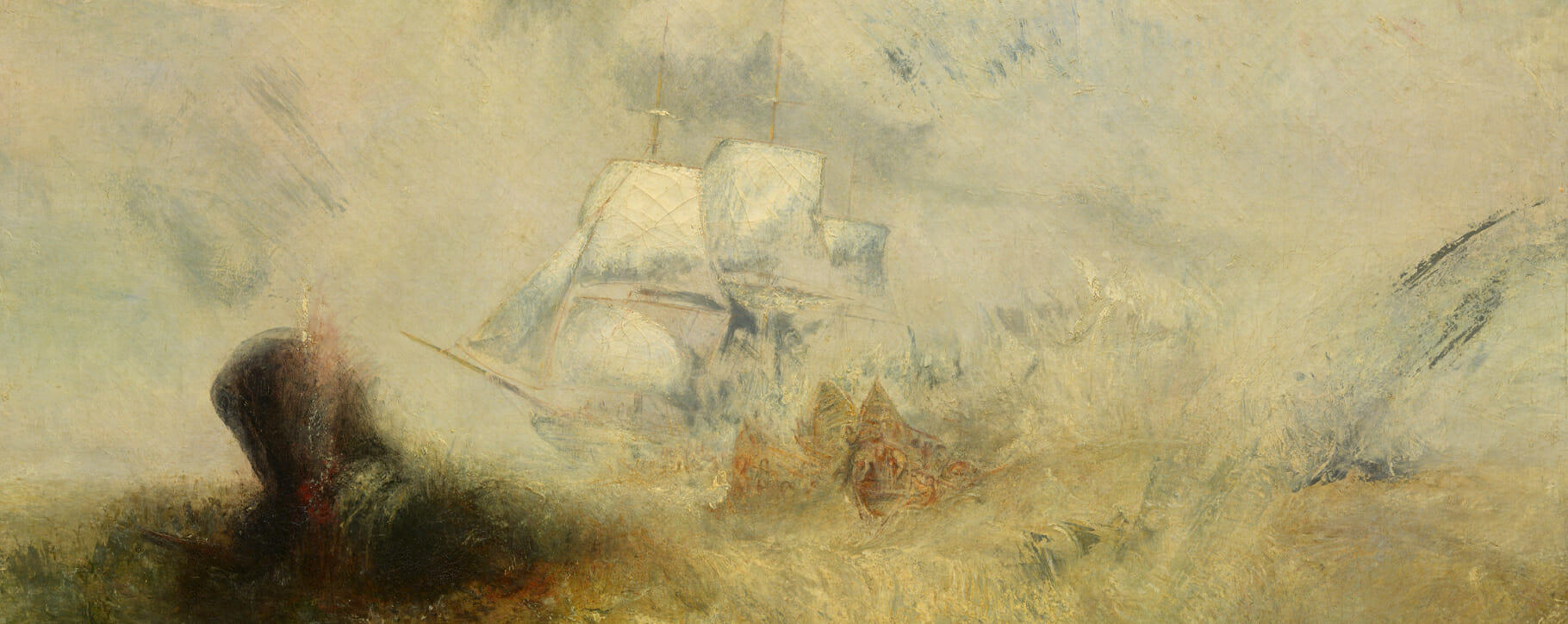 Above: a detail from ‘Whalers’ by Joseph Mallord William Turner, 1845
Above: a detail from ‘Whalers’ by Joseph Mallord William Turner, 1845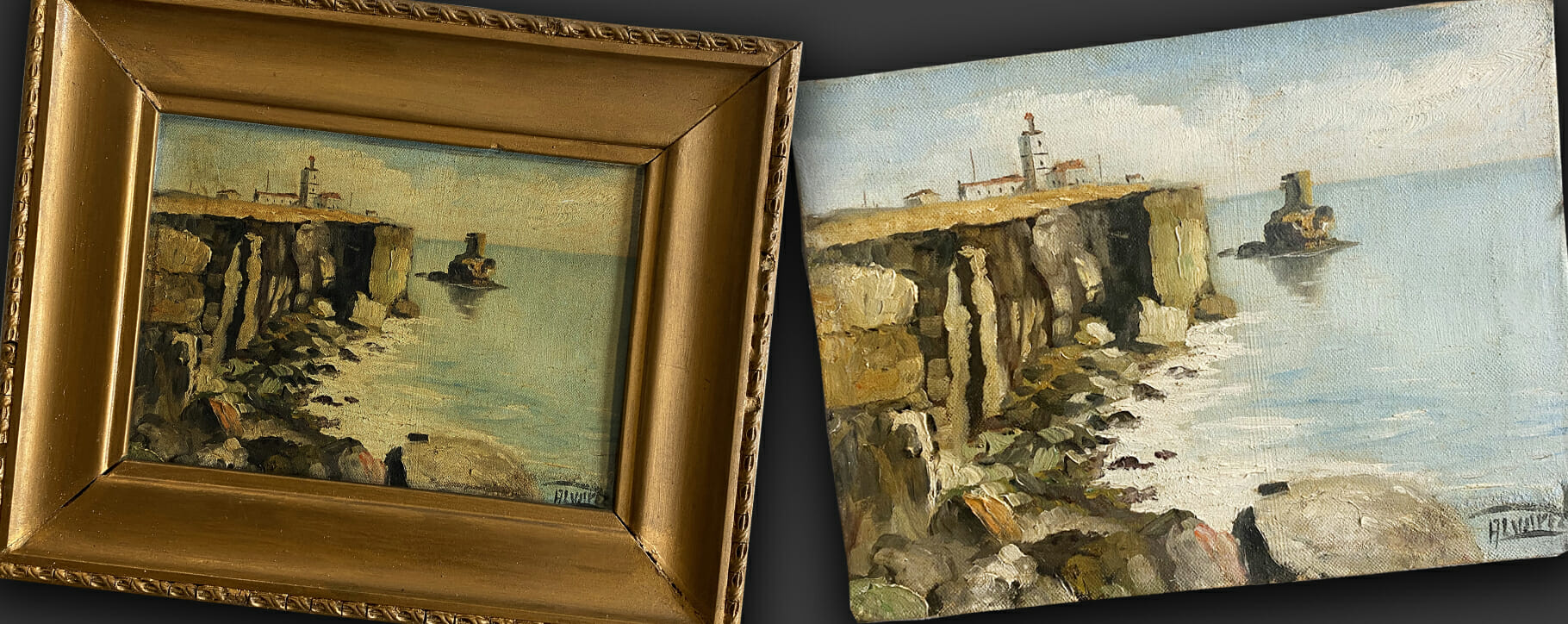 Above: a nicotine stained ocean view before and after a varnish removal and surface clean by our conservators
Above: a nicotine stained ocean view before and after a varnish removal and surface clean by our conservators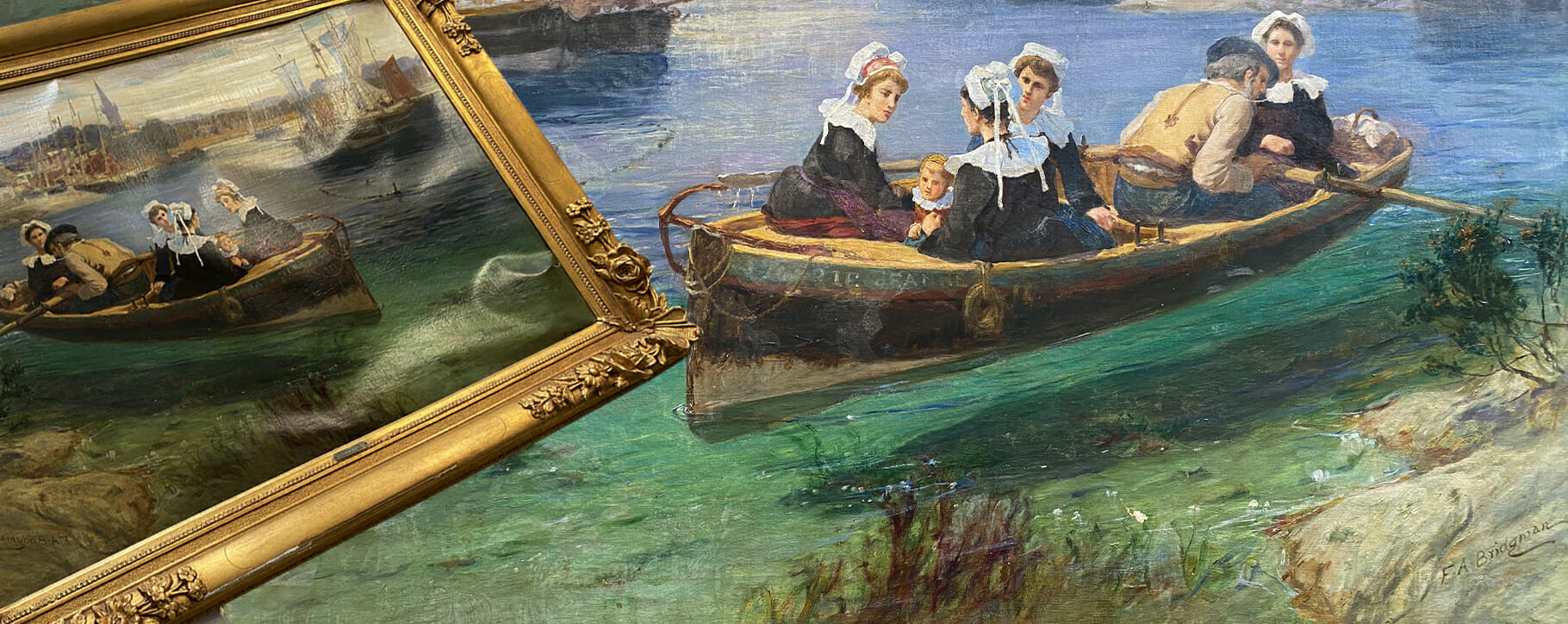 Above: the painting warped in the frame after falling from height (right) and the painting following restoration by our team (left)
Above: the painting warped in the frame after falling from height (right) and the painting following restoration by our team (left) Above: the sunset boat scene before restoration with disturbances caused by accidental damage in the upper left corner
Above: the sunset boat scene before restoration with disturbances caused by accidental damage in the upper left corner Above: before and after a discoloured varnish removal by our conservators on a George Morland nautical scene of smugglers in a cove
Above: before and after a discoloured varnish removal by our conservators on a George Morland nautical scene of smugglers in a cove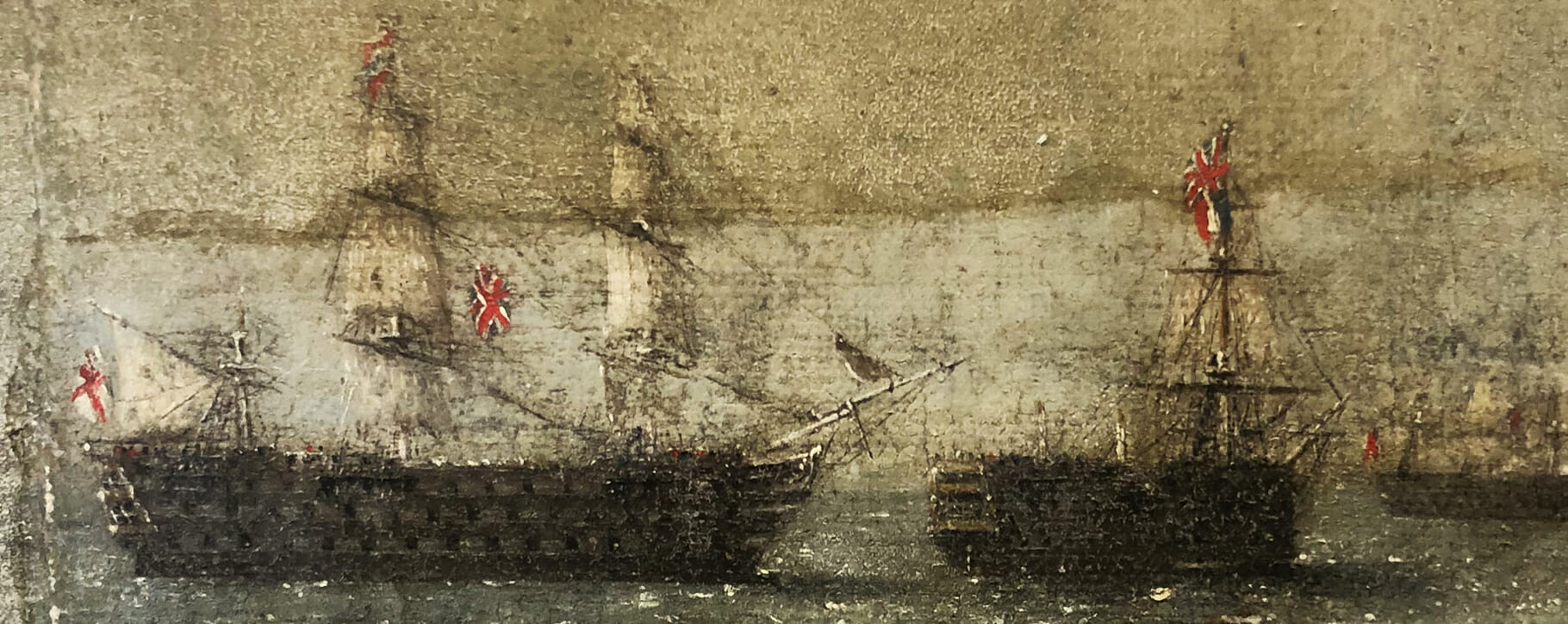 Above: a painting with British ships with a thick layer of smoke and soot damage, part way through removal of contamination by our team
Above: a painting with British ships with a thick layer of smoke and soot damage, part way through removal of contamination by our team




